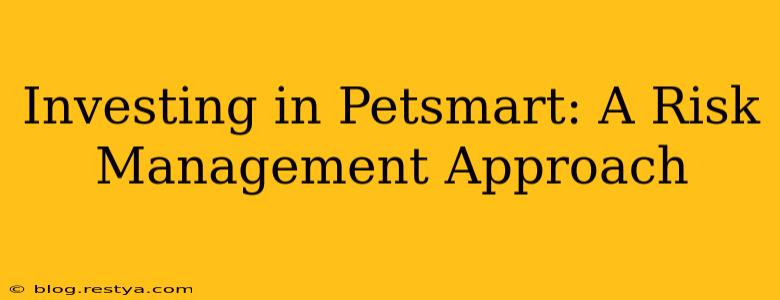The pet industry is booming, and PetSmart, a leading pet retailer, has positioned itself at the heart of this growth. But like any investment, venturing into PetSmart stock requires a thorough understanding of the potential risks involved. This isn't just about chasing returns; it's about navigating a landscape filled with both opportunities and challenges. Let's embark on a journey to explore the smart way to assess PetSmart as an investment, focusing on effective risk management.
Is PetSmart a Good Investment Right Now?
This is the million-dollar question, and unfortunately, there's no simple yes or no answer. The "goodness" of an investment depends heavily on your individual risk tolerance, investment timeline, and overall portfolio strategy. PetSmart's performance is influenced by numerous factors, from economic fluctuations to changing consumer preferences and competitive pressures. A thorough due diligence process is essential before committing your capital. We'll delve into specific risks to help you determine if PetSmart aligns with your risk profile.
What are the Risks of Investing in PetSmart?
Several key risks warrant careful consideration before investing in PetSmart. Understanding these risks is crucial for effective risk management.
Economic Downturns and Consumer Spending:
PetSmart, like many discretionary retailers, is susceptible to economic downturns. When economic conditions worsen, consumers may cut back on non-essential spending, including pet supplies. This directly impacts PetSmart's revenue and profitability. Historically, pet ownership has remained relatively resilient even during recessions, but the degree of spending on premium products and services can fluctuate significantly.
Competition from Online Retailers and Smaller Pet Stores:
The rise of e-commerce giants like Amazon and Chewy poses a significant challenge to brick-and-mortar retailers like PetSmart. These online platforms offer convenience, price competition, and a vast selection of products. Furthermore, smaller, independent pet stores often offer a more personalized and specialized shopping experience, further fragmenting the market.
Supply Chain Disruptions:
Global supply chain disruptions can impact the availability of pet food, supplies, and other products, leading to shortages and potentially affecting PetSmart's ability to meet customer demand. This vulnerability highlights the importance of diversifying investment portfolios to mitigate risk across various sectors.
Changes in Consumer Preferences and Pet Ownership Trends:
Consumer preferences are constantly evolving. Shifts in pet ownership trends (e.g., breed popularity, pet food choices) can influence demand for specific products and require PetSmart to adapt its inventory and offerings. Failure to adapt quickly could lead to lost sales and market share.
Regulatory Changes and Animal Welfare Concerns:
The pet industry is subject to various regulations related to animal welfare, product safety, and environmental concerns. Changes in regulations can impose additional costs on PetSmart and potentially affect its operations. Maintaining a strong ethical and responsible approach to animal welfare is crucial for long-term sustainability and positive brand image.
What is PetSmart's Future Outlook?
Predicting the future of any company is challenging, but analyzing PetSmart's strategic initiatives and market position can offer some insights. Their focus on omnichannel retail (combining online and in-store experiences), private label brands, and services like grooming and veterinary care suggests a proactive approach to adapt to the changing market landscape. However, the success of these strategies will depend on effective execution and consumer response.
How Can I Mitigate the Risks of Investing in PetSmart?
Effective risk management is paramount when investing in any stock. Here are some key strategies:
- Diversification: Don't put all your eggs in one basket. Diversify your investment portfolio across various asset classes and sectors to reduce overall risk.
- Thorough Research: Conduct in-depth research on PetSmart's financial performance, competitive landscape, and strategic initiatives. Analyze financial statements, industry reports, and analyst opinions.
- Long-Term Perspective: Consider a long-term investment horizon. Short-term market fluctuations are normal, and a long-term approach can help weather temporary setbacks.
- Risk Tolerance Assessment: Understand your own risk tolerance. If you're risk-averse, consider investing a smaller portion of your portfolio in PetSmart.
- Monitor Regularly: Stay informed about PetSmart's performance and the broader pet industry. Regularly review your investment and make adjustments as needed.
Investing in PetSmart, or any company, requires careful consideration of the risks involved. By employing a thorough risk management approach and conducting diligent research, you can make informed decisions that align with your investment goals and risk tolerance. Remember, this information is for educational purposes and should not be considered financial advice. Always consult with a qualified financial advisor before making any investment decisions.

